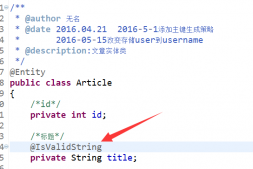本文实例讲述了java基于享元模式实现五子棋游戏功能。分享给大家供大家参考,具体如下:
一、模式定义
享元模式,以共享的方式高效地支持大量的细粒度对象。通过复用内存中已存在的对象,降低系统创建对象实例的性能消耗。享元的英文是flyweight,表示特别小的对象,即细粒度对象。
二、模式举例
1. 模式分析
我们借用五子棋游戏来说明这一模式。

2. 享元模式静态类图

3. 代码示例
3.1 创建抽象棋子一abstractchessman
|
1
2
3
4
5
6
7
8
9
10
11
12
13
14
15
16
17
|
package com.demo.flyweight.object;public abstract class abstractchessman { // 棋子坐标 protected int x; protected int y; // 棋子类别(黑|白) protected string chess; public abstractchessman(string chess) { this.chess = chess; } // 点坐标设置 public abstract void point(int x, int y); // 显示棋子信息 public void show() { system.out.println(this.chess + "(" + this.x + "," + this.y + ")"); }} |
3.2 创建黑子一blackchessman
|
1
2
3
4
5
6
7
8
9
10
11
12
13
14
15
16
17
18
|
package com.demo.flyweight.object;public class blackchessman extends abstractchessman { /** * 构造方法 初始化黑棋子 */ public blackchessman() { super("●"); system.out.println("--blackchessman construction exec!!!"); } // 点坐标设置 @override public void point(int x, int y) { this.x = x; this.y = y; // 显示棋子内容 show(); }} |
3.3 创建白子一whitechessman
|
1
2
3
4
5
6
7
8
9
10
11
12
13
14
15
16
17
18
|
package com.demo.flyweight.object;public class whitechessman extends abstractchessman { /** * 构造方法 初始化白棋子 */ public whitechessman() { super("○"); system.out.println("--whitechessman construction exec!!!"); } // 点坐标设置 @override public void point(int x, int y) { this.x = x; this.y = y; // 显示棋子内容 show(); }} |
3.4 创建棋子工厂一fivechessmanfactory
|
1
2
3
4
5
6
7
8
9
10
11
12
13
14
15
16
17
18
19
20
21
22
23
24
25
26
27
28
29
30
31
32
33
34
35
36
37
38
39
40
41
42
43
44
45
46
47
48
49
|
package com.demo.flyweight.factory;import java.util.hashtable;import com.demo.flyweight.object.abstractchessman;import com.demo.flyweight.object.blackchessman;import com.demo.flyweight.object.whitechessman;public class fivechessmanfactory { // 单例模式工厂 private static fivechessmanfactory fivechessmanfactory = new fivechessmanfactory(); // 缓存存放共享对象 private final hashtable<character, abstractchessman> cache = new hashtable<character, abstractchessman>(); // 私有化构造方法 private fivechessmanfactory() { } // 获得单例工厂 public static fivechessmanfactory getinstance() { return fivechessmanfactory; } /** * 根据字符获得棋子 * * @param c * (b:黑棋 w:白棋) * @return */ public abstractchessman getchessmanobject(char c) { // 从缓存中获得棋子对象实例 abstractchessman abstractchessman = this.cache.get(c); if (abstractchessman == null) { // 缓存中没有棋子对象实例信息 则创建棋子对象实例 并放入缓存 switch (c) { case 'b': abstractchessman = new blackchessman(); break; case 'w': abstractchessman = new whitechessman(); break; default: break; } // 为防止 非法字符的进入 返回null if (abstractchessman != null) { // 放入缓存 this.cache.put(c, abstractchessman); } } // 如果缓存中存在 棋子对象则直接返回 return abstractchessman; }} |
3.5 客户端实现一client
|
1
2
3
4
5
6
7
8
9
10
11
12
13
14
15
16
17
18
19
20
21
22
23
24
25
26
27
28
29
30
31
32
33
34
35
36
37
38
39
|
package com.demo;import java.util.random;import com.demo.flyweight.factory.fivechessmanfactory;import com.demo.flyweight.object.abstractchessman;/** * 主应用程序 * * @author */public class client { /** * @param args */ public static void main(string[] args) { // 创建五子棋工厂 fivechessmanfactory fivechessmanfactory = fivechessmanfactory .getinstance(); random random = new random(); int radom = 0; abstractchessman abstractchessman = null; // 随机获得棋子 for (int i = 0; i < 10; i++) { radom = random.nextint(2); switch (radom) { // 获得黑棋 case 0: abstractchessman = fivechessmanfactory.getchessmanobject('b'); break; // 获得白棋 case 1: abstractchessman = fivechessmanfactory.getchessmanobject('w'); break; } if (abstractchessman != null) { abstractchessman.point(i, random.nextint(15)); } } }} |
4. 运行结果
--whitechessman construction exec!!!
○(0,2)
○(1,6)
--blackchessman construction exec!!!
●(2,3)
○(3,14)
○(4,13)
○(5,8)
●(6,14)
●(7,0)
●(8,3)
○(9,8)
三、享元模式的两种状态
内蕴状态:不会随环境的改变而改变,是存储在享元对象内部状态信息,困此内蕴状态是可以共享的,对于任何一个享元对象来讲,它的值是完全相同的。就像五子棋中的"黑子"和"白子",它代表的状态就是内蕴状态。
外蕴状态:它会随环境的改变而改变,因此不可以共享状态,对于不同的享元对象讲,它的值可能是不同的。享元对象的外蕴状态必须由客户端保存,在享元对象被创建之后,需要使用的时候再传入享元对象内部。就像五子棋的位置信息,代表的状态就是享元对象的外蕴状态。
所以,享元的外蕴状态和内蕴状态是两类相互独立的状态,彼此没关联。
四、该模式设计原则
1. 共享细粒度对象,降低内存空间。
2. 有效地隔离系统中变化部分和不变部分。
五、使用场合
1. 当系统中某个对象类型的实例较多的时候。
2. 在系统设计中,对象实例进行分类后,发现真正有区别的分类很少的时候。
六、享元模式静态类图

希望本文所述对大家java程序设计有所帮助。
原文链接:https://blog.csdn.net/chengqiuming/article/details/70139362















